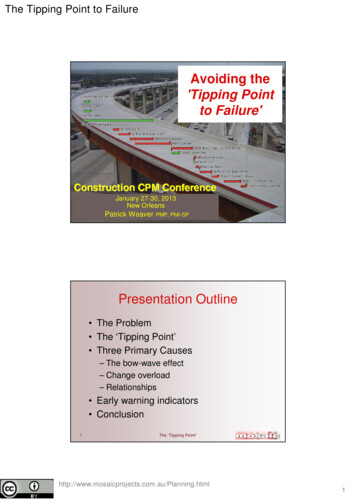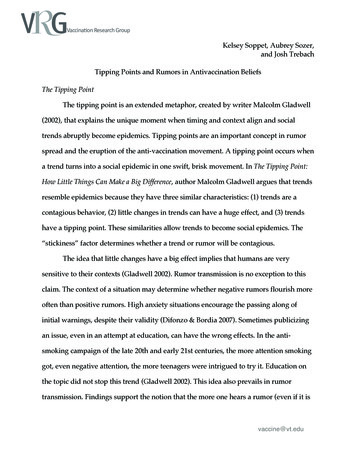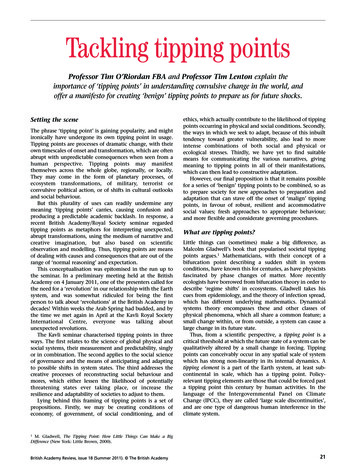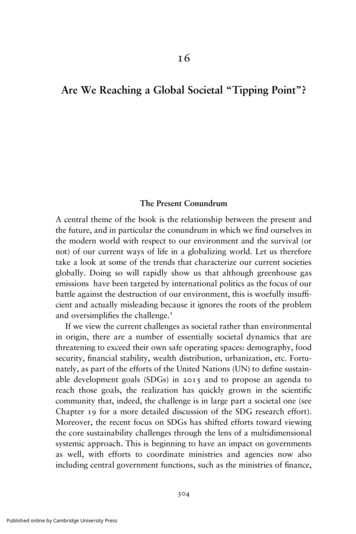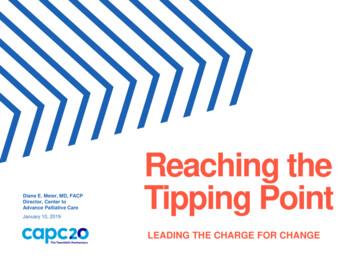
Transcription
Diane E. Meier, MD, FACPDirector, Center toAdvance Palliative CareJanuary 10, 2019Reaching theTipping PointLEADING THE CHARGE FOR CHANGE
OVERVIEWThe Center to Advance PalliativeCare was founded in 1999 with asignificant multiyear grant from theRobert Wood Johnson Foundation.It launched with an explicitcharge to scale access topalliative care nationwide.2
OVERVIEWTo that end, for 20 years CAPC hasbeen dedicated to disseminatingtools, training, and technicalassistance to promote access tohigh-quality, sustainable palliativecare in all health care settings.3
OVERVIEWIn 2015, CAPC became a membershiporganization to stabilize its futuresustainability and to support bringingpalliative care to scale in the United States.Today, CAPC serves more than 1,370member health care organizations, whilealso driving public awareness and demand,supportive policy and payment, andstandardization of quality.4
OVERVIEW5
SUCCESS:THE RAPIDADOPTION OFPALLIATIVE CARE
Hospitals (50 beds) withPalliative 00220042006# of hospitals with palliative care72008201020122014% of hospitals with palliative care2016
Community-Based Palliative Care: 800Programs Serving 2,000 Sites8 434 Offices orClinics 1,137 NursingHomes 537 programsserving patient’shomes in 1,300counties
Growth of Palliative Care% Market ShareHospitalCommunity9
SUCCESSAccess is improving, but we have a way togo: It is estimated that fewer than 5% of people living withserious illness who could benefit actually receive careinformed by palliative care principles and practices. Barriers include lack of training of frontline clinicians in thecore skills of communication, symptom management, andfamily support over time; unreliable financing; deficits inspecialist workforce; and persistent misunderstanding ofeligibility for, and benefits of, palliative care.10
SUCCESSOur growth as a field so far wascatalyzed by tens of millions ofdollars in philanthropic support forinnovation, dissemination, andprofessionalization, but mostimportantly . . .11
SUCCESS by envisioning adifferent future12
DIFFUSIONOFINNOVATION
DIFFUSION OF INNOVATIONThe aim of CAPC’s focus ontechnical assistance anddissemination of knowledge andskill to the field is to reduce theopportunity cost of start-up and tohelp catalyze rapid growth in thenumbers and quality of palliativecare programs.14
DIFFUSION OF INNOVATIONAccelerated byprofessionalization andstandardization via The CAPCModel and the Palliative CareLeadership Centers (PCLC)15
DIFFUSION OF INNOVATIONHelping program leaders todemonstrate quality and financialoutcomes for their organizations, inturn driving executives’commitment to palliative care.16
DIFFUSION OF INNOVATIONIn his 1962 book, TheDiffusion ofInnovations, EverettRogers argued thatdiffusion is the processby which an innovationis communicated thruchannels over timeamong participants in asocial system.17
DIFFUSION OF INNOVATIONAccording to Rogers, four mainelements influence the spread of anew idea:The innovation itself Communication channels Time A social system18
DIFFUSION OF INNOVATIONThis is whereyou come in.19
DIFFUSION OF INNOVATIONIn order for an innovation to scale,it must be widely adopted. Andthere is a point at which adoption ofan innovation reaches critical massor a tipping point.20
DIFFUSION OF INNOVATIONCAPC is launching ProjectTipping Point a 5-yearcampaign to drive palliative careprinciples and practices into thestandard of practice for care ofpeople living with a serious illness,and their families and othercaregivers.21
REACHING THETIPPING POINT
REACHING THE TIPPING POINTTipping PointThe critical point in a situation,process, or system beyond which asignificant and often unstoppableeffect or change takes place.23
REACHING THE TIPPING POINTCAPC’s initial Tipping Point goal is focusedon the frontline clinical workforce— in aneffort to ensure that all clinicians andorganizations have the knowledge and skillsnecessary to provide better care to theirpatients living with a serious illness.This goal applies to all clinicians, palliativecare specialists and non-palliative carespecialists alike.24
The literature suggests that a tippingpoint for social transformation isreached when roughly 25% of peopleor organizations adopt the innovation.(Source: Centola, D, Becker, J, et al. Experimental evidence for tipping points in socialconvention. Science. 08 Jun 2018:vol. 360, Issue 6393, pp. 1116-1119)25
Our first year Tipping Point Challenge goal isto strengthen the skills needed by theclinical workforce to improve care for peopleliving with serious illness-- until we reachthat tipping point of 25% of clinicians ineach health care organization.26
Course Completions①Highest # coursecompletions in 2019; or②Highest # coursecompletions sincebecoming a CAPCmemberFourChallengeCategories27CAPC Designations③Highest # Designations in2019; or④Highest # Designationssince becoming a CAPCmember
The result? Clinicians will improve skills that transformpractice and improve the quality of patient care. Patients and families will experience improvedinteractions with clinical staff, leading to bettercare and quality of life. Organizations will care more reliably forpatients and families living with serious illness,expand their abilities to achieve their mission,improve affordability, and make a positive impacton the communities they serve.28
Say Happy 20th Anniversary toCAPC! by joining the ProjectTipping Point campaign Take the Tipping Point Challenge!29
LEARN MORE.MEET THECHALLENGE.Go to tippingpointchallenge.capc.org
The literature suggests that a tipping point for social transformation is reached when roughly 25% of people or organizations adopt the innovation. (Source: Centola, D, Becker, J, et al. Experimental evidence for tipping points in social convention. Science. 08 Jun 2018:vol. 360, Issue 6393, pp. 1116-1119) 25

